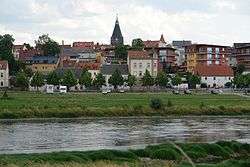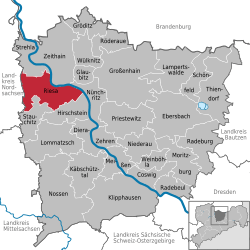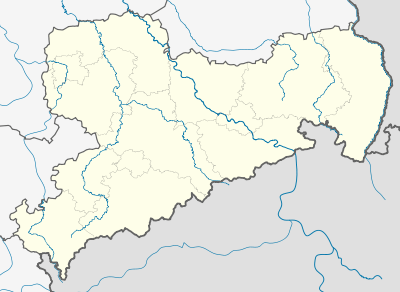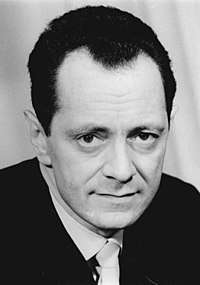Riesa
Riesa is a town in the district of Meißen in the Free State of Saxony, Germany. It is located on the Elbe River, approximately 40 kilometres (25 miles) northwest of Dresden.
Riesa | |
|---|---|
 | |
 Coat of arms | |
Location of Riesa within Meißen district  | |
 Riesa  Riesa | |
| Coordinates: 51°18′29″N 13°17′38″E | |
| Country | Germany |
| State | Saxony |
| District | Meißen |
| Subdivisions | 16 |
| Government | |
| • Mayor | Marco Müller (CDU) |
| Area | |
| • Total | 58.91 km2 (22.75 sq mi) |
| Elevation | 109 m (358 ft) |
| Population (2018-12-31)[1] | |
| • Total | 30,054 |
| • Density | 510/km2 (1,300/sq mi) |
| Time zone | CET/CEST (UTC+1/+2) |
| Postal codes | 01587, 01589, 01591, 01594 |
| Dialling codes | 03525 |
| Vehicle registration | MEI, GRH, RG, RIE |
| Website | www.riesa.de |
History
The name Riesa is derived from Slavic Riezowe. This name, romanised as "Rezoa", appears first in October 1119 in a document from Pope Callixtus II.
The world's first 110 kV power line was installed between Riesa and Lauchhammer in 1912. Between 1952 and 1994, Riesa was the seat of a district.
During the 1980s, Riesa was the headquarters of the Group of Soviet Forces in Germany's 9th Tank Division.
Population history
The city grew from the start of the 20th century due to industrialisation. The population declined after German Reunification in 1989. The local steel works shut and the population fell from 52,000 to 31,000.
| Historical Population of Riesa | ||||||||||||
|---|---|---|---|---|---|---|---|---|---|---|---|---|
| Year | 1575 | 1834 | 1849 | 1875 | 1880 | 1900 | 1933 | 1939 | 1946 | 1950 | 1960 | 1981 |
| Population | 350 | 1,631 | 2,679 | 5,707 | 6,259 | 13,491 | 26,248 | 29,963 | 34,406 | 36,150 | 36,769 | 51,857 |
| Year | 1995 | 2000 | 2005 | 2010 | 2011 | 2012 | 2013 | 2014 | 2015 | 2016 | 2017 | 2018[2] |
| Population | 42,429 | 39,367 | 36,221 | 33,351 | 32,879 | 32,368 | 32,032 | 31,654 | 31,541 | 31,519 | 31,080 | 30,953 |
Sons and daughters of the city

- Adolph von Carlowitz (1858-1928), Saxon officer, general of the infantry and war minister
- Dieter Noll (1927-2008), writer
- Jürgen Schmieder (born 1952), politician
- Monika Zehrt (born 1952), athlete
- Heiko Peschke (born 1963), footballer
- Johannes Müller (theologian) (1864-1949)
- Ulf Kirsten (born 1965), footballer
- Rüdiger Heinze (born 1971), film producer and screenwriter
- Rolf Moebius (1915-2004), actor
Personalities connected with the city
- Walter Fritzsch (1920-1997), soccer coach
- Wolfgang Lischke (born 1947), former footballer
- Peter Kotte (born 1954), former footballer
- Harald Czudaj (born 1963), bobber and entrepreneur
- Ralf Hauptmann (born 1968), soccer player
Sights


Riesa has a 25 m tall, 234 tonne, cast-iron (GGG 40) sculpture of an oak trunk, named Elbquelle, which means source of the Elbe, by Jörg Immendorff, erected in 1999. Local folk call the sculpture by many other names, most notably "Rostige Eiche", which means "rusty oak".
In the city of Riesa there are two famous churches. The minster St. Marien was built in 1261 as an addition to the Benedictine Abbey. The Trinitatis Church was completed in 1897.
Riesa is known locally for the SACHSENarena, a large hall which hosted the European Sumo Wrestling Championship in October 2003 and the World Sumo Wrestling Championship in October 2004.
Culture
Riesa is well known locally for its pasta, which is produced at Teigwaren Riesa GmbH. Another symbol of Riesa are the Riesaer Zündhölzer, the matches which were traditionally manufactured there.
Very famous is also the steel production in Riesa.
Notable people from Riesa include the former footballer Ulf Kirsten. Riesa has a football club, BSG Stahl Riesa. The club's crest is blue and white, as are the club colours. They play now in the Landesliga Sachsen (6th. League).
Twin towns - sister cities
Riesa is twinned with:[3]




Transport
Riesa railway station is located north of the town's centre, it offers both regional and long-distance services.
Riesa is located on Bundesstraße 169, which ensures access to federal motorways A 14 (close to Döbeln, approx. 25 km) and A 13 (close to Ruhland, approx. 50 km).
References
- "Bevölkerung des Freistaates Sachsen jeweils am Monatsende ausgewählter Berichtsmonate nach Gemeinden" (PDF). Statistisches Landesamt des Freistaates Sachsen (in German). July 2019.
- Stadt Riesa (April 2018). "Statistik 1. Quartal 2018" (PDF) (in German). Retrieved 06.07.2018. Check date values in:
|accessdate=(help) - "Partnerstädte". riesa.de (in German). Riesa. Retrieved 2019-12-16.
External links
- Riesa tourism site
- Official Web site
- Official Web site of Stahl Riesa Footballclub

- "Riesa". Encyclopædia Britannica (11th ed.). 1911.
- "Riesa". New International Encyclopedia. 1905.